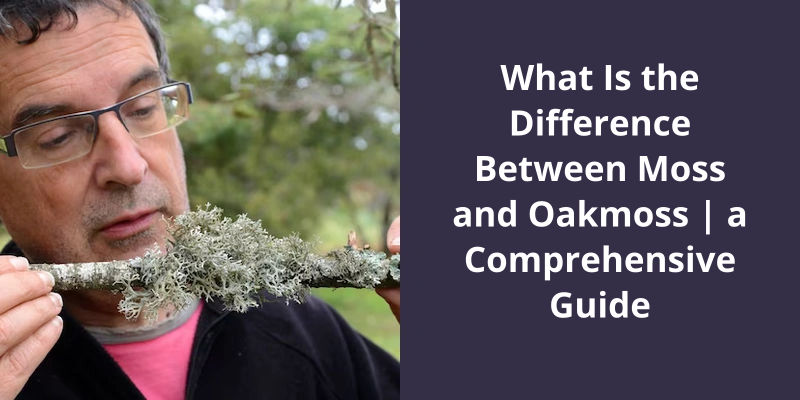Moss and oakmoss may sound similar, but they’re quite different from one another. While moss falls into the category of bryophytes, which are non-vascular land plants that include liverworts, hornworts, and mosses, oakmoss is actually a type of lichen. Lichens are a combination of fungi and microscopic green algae or cyanobacteria, and they can be found all over the world. Oakmoss, specifically, is prevalent in Central and Southern Europe, growing on oak trees. Understanding the difference between these two organisms can help us appreciate the biodiversity around us, as well as their unique characteristics and functions in their respective ecosystems.

How Do You Identify Oakmoss?
Oakmoss is a type of lichen that can be found growing on the bark of trees in temperate and subtropical regions of the world. It’s commonly used in perfumes and fragrances for it’s earthy, woody scent. Luckily, there are a few distinguishing characteristics that can help you identify oakmoss.
One of the most obvious characteristics of oakmoss is it’s flattened, leafy branches. Unlike other lichens that may have angular branches or a more rounded, ball-like appearance, oakmoss branches are flat and spread out like tiny leaves. They can range in color from greenish-gray to brownish-green, depending on the species and the conditions in which they’re growing.
Some species may have more rounded branches or a lighter color overall, while others may have a stronger, more pungent scent.
With a little bit of practice and patience, however, anyone can learn to recognize this distinctive lichen and appreciate it’s beauty and fragrance.
A Guide on How to Harvest Oakmoss Sustainably
- Gather necessary tools and equipment
- Identify the oakmoss species you want to harvest
- Choose a location with healthy oakmoss populations
- Harvest only mature oakmoss plants
- Take only a small amount of oakmoss from each plant
- Allow oakmoss to regenerate before harvesting again
- Avoid harvesting from protected areas or private property without permission
- Properly dry and store harvested oakmoss
- Dispose of any waste or trimmings properly
- Consider alternative sustainable substitutes for oakmoss in products
Now that we know where Oakmoss Lichen can be found, let’s explore it’s uses and benefits. From perfumery to medicinal applications, this remarkable plant has many properties that have been utilized for centuries. So, let’s delve deeper into the world of Oakmoss Lichen and discover what makes it so special.
Where Do You Find Oakmoss?
Oakmoss Lichen, also known as Evernia prunastri, is a unique species that’s highly valued in the world of perfumery. It’s often used as an ingredient in creating perfumes and colognes due to it’s earthy and woody scent. However, the Oakmoss Lichen isn’t easy to find, and it isn’t widely available in most areas.
This elusive lichen species is typically found in northern Wisconsin, where it grows on conifer twigs. Due to it’s scarcity and special status, the Oakmoss Lichen is classified as a Wisconsin Special Concern plant. This means that it’s protected under state law, and it’s illegal to harvest or disturb this species without a permit.
Therefore, finding this species requires a bit of searching and patience. If you’re lucky enough to come across the Oakmoss Lichen, you can easily identify it year-round due to it’s distinct appearance.
The Oakmoss Lichen has a unique growth pattern that’s easily recognizable. It forms clusters of small, bushy tufts that grow outwards from the twig it’s attached to. The tufts are made up of small, branched fronds that have a distinctive hairy texture. The color of the Oakmoss Lichen can vary from green to gray, depending on the amount of light it receives and the environment in which it grows.
The History and Cultural Significance of Oakmoss Lichen in Perfumery
Oakmoss Lichen is a unique ingredient that’s been used in perfumery for centuries. It’s a type of fungus that grows on oak trees and has a distinctive scent that’s earthy, woody, and slightly sweet. Oakmoss Lichen has been prized for it’s aroma and fixative properties, which allow fragrances to last longer on the skin. However, due to environmental concerns, synthetic substitutes are now often used instead of the natural ingredient. Despite this, Oakmoss Lichen remains an important part of perfumery history and culture.
Now that we’ve a better understanding of how oakmoss looks, we can delve into it’s unique aroma and what makes it such a sought-after ingredient in the fragrance industry.
What Does Oakmoss Look Like?
Oakmoss is a type of lichen that’s commonly found in wooded and forested areas. It grows on the branches and trunks of trees, and can be seen clinging to the bark. It’s easy to recognize due to it’s unique appearance, which is unlike any other type of plant or fungus. The shape and texture of the thallus, as well as the color, are all characteristic of this species.
The thallus of oakmoss is made up of small, flat branches that grow out from a central point. These branches can be quite long, reaching up to several inches in length. The overall shape of the thallus is relatively flat, almost like a small piece of ribbon. When the thallus is dry, it can be quite stiff and brittle, but when it’s wet, it becomes soft and pliable.
The color of oakmoss can vary depending on a number of factors. In general, it’s green or greenish-white when dry, and dark olive-green to yellow-green when wet. This variation in color can be quite striking, particularly when the oakmoss is growing on a tree trunk that’s covered in white snow. The color also changes with age, with older thalli becoming darker and more brown in appearance than younger ones.
The texture of oakmoss thalli is another characteristic feature. The surface of the thallus is rough and pebbly when dry, with small bumps and ridges all over it’s surface. When it’s wet, it becomes smooth and rubbery, almost like the surface of a wet mushroom. These characteristics make it easy to identify oakmoss, even from a distance.
Despite being such a distinct and recognizable species, oakmoss is often overlooked by those who aren’t familiar with forest ecology. Nevertheless, it plays an important role in the ecosystem, providing habitat for a variety of insects and small animals. It also contains a number of chemical compounds that are valued in perfumery, making it a valuable resource for those in the fragrance industry.
The Ecological Importance of Oakmoss in Forest Ecosystems and How It Supports Biodiversity
Oakmoss is a type of lichen that grows on oak trees and other deciduous trees in forests. It plays a crucial role in forest ecosystems by providing habitat and food for a wide variety of organisms, including insects, birds, and mammals. Oakmoss is also important for it’s ability to improve soil quality and nutrient cycling. It’s removal can lead to a loss of biodiversity and ecological function in forests.
However, there are other scents that can complement the rich and earthy tones of oakmoss. From zesty citrus notes to warm and spicy scents, the possibilities are endless. Keep reading to discover some of the best fragrances that pair well with the aromatic oakmoss.
What Smells Like Oakmoss?
Oakmoss is a highly valued ingredient in the perfumery industry. It’s a type of lichen that grows on oak trees and has a distinct earthy, woody fragrance. It’s a unique scent profile that’s both fresh and musky. The scent of oakmoss can be described as earthy, mossy, and rich.
Similar scents to oakmoss include patchouli, vetiver, and musk. Patchouli is often used in perfumes to create a long-lasting base note. It’s a sweet, woody scent that blends well with oakmoss. Vetiver is a type of grass that’s a woody, smoky scent. It’s often used in mens fragrances and works well with oakmoss. Musk is a synthetic fragrance that mimics the smell of animal musk.
Complementing notes that work well with oakmoss include citrus, floral, and spicy scents. Citrus scents like bergamot and lemon can add a fresh, bright dimension to oakmoss fragrances. Floral notes like jasmine and rose can soften the earthy scent of oakmoss and add a feminine touch.
It’s earthy, woody scent profile makes it a popular choice for mens fragrances, as well as unisex scents.
While oakmoss has been used for centuries in various industries, concerns regarding it’s safety have risen due to the presence of toxic chemicals. Although it can be used in small amounts without causing harm, excessive consumption or use of it’s alcohol extract can lead to various side effects such as vomiting, dizziness, tremors, kidney damage and liver damage. Therefore, caution is advised when using or consuming oakmoss.
Is Oakmoss Safe?
Oak moss is a type of moss that’s commonly used in perfumes and fragrances due to it’s earthy and woody scent. However, there’s been growing concern about the safety of oak moss in recent years, particularly regarding it’s potential toxicity.
These chemicals are known to cause skin irritation and allergic reactions in some people, and can also lead to more serious health problems if ingested in large amounts.
This is largely due to the high concentration of atranol and chloroatranol found in these forms of the moss. Ingesting large amounts of oak moss can cause a range of side effects, including vomiting, dizziness, tremors, kidney damage, and liver damage.
Despite the potential risks associated with oak moss, it’s still commonly used in the fragrance industry. However, there are regulations in place to limit the concentration of atranol and chloroatranol in fragrances, reducing the risk of harmful exposure.
If you experience any symptoms of toxicity or allergic reactions, seek medical attention right away.
To avoid adverse effects, it’s important to limit exposure to high concentrations of the moss and to seek medical attention if any symptoms of toxicity or allergic reactions occur.
Oakmoss has been a popular ingredient in traditional medicines and perfumes for centuries. One of it’s key benefits is it’s ability to ease respiratory issues by loosening phlegm. Additionally, it’s essential oil is known for it’s calming properties and can be used as an alternative medicine to prevent and treat a wide range of diseases. In this article, we will explore Oakmoss and it’s various applications in more detail.
What Is Oakmoss Used For?
Oakmoss is a common ingredient found in many different products, ranging from perfumes to cleaning supplies. This versatile substance is actually a type of lichen and is harvested from various species of trees such as oak and pine. Oakmoss has been used for centuries for medicinal purposes and as a natural remedy for coughs and other respiratory issues.
One of the most significant benefits of oakmoss is it’s ability to loosen phlegm and aid in it’s removal. This makes it particularly useful for individuals who’re suffering from coughing and other respiratory issues.
The essential oil of oakmoss is high in compounds that have calming and relaxing properties. This makes it an excellent supplement for those who suffer from anxiety or have trouble sleeping. As a natural supplement, it can be taken orally or applied topically to help promote relaxation and a sense of wellbeing.
It’s a strong and distinct scent that’s both familiar and captivating. It’s often blended with other ingredients to create unique and complex fragrances that are popular among both women and men.
This is due to it’s natural ability to absorb odors and freshen up spaces. It can be used to remove unwanted smells from carpets, upholstery, and other fabrics. It’s also excellent for freshening up musty closets and storage spaces. It’s natural properties make it a safe and effective alternative to synthetic cleaning products.
It can be used as an essential oil, a natural remedy, a fragrance, and a cleaning agent. It’s ability to soothe and relax the respiratory system makes it an excellent tool for those struggling with respiratory issues. It’s calming and relaxing properties also make it a popular choice for those looking to manage anxiety and stress. Additionally, it’s natural odor-absorbing properties make it a safe and effective choice for natural cleaning and freshening.
What Are Some Popular Perfumes and Fragrances That Contain Oakmoss?
- Chanel No. 19
- Guerlain Mitsouko
- Chanel Cristalle
- Dior Diorella
- Guerlain Jicky
- Ralph Lauren Safari
- Yves Saint Laurent Rive Gauche
- Guerlain Chant d’Aromes
- Estee Lauder Knowing
- Dolce & Gabbana Light Blue
Source: Benefits of Natural Oakmoss Extracts and … – BMV Fragrances
Conclusion
As for their growth patterns, mosses are typically found in moist and shady environments, while oakmoss thrives on oak trees in Central and Southern Europe.





